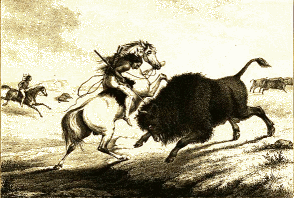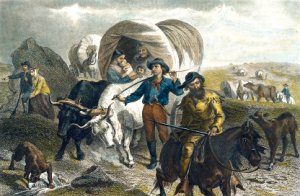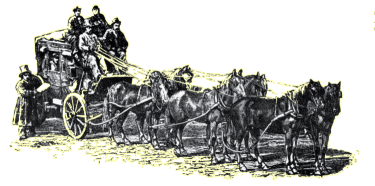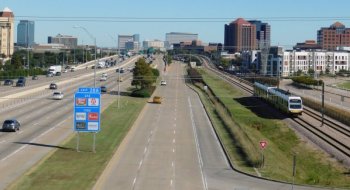Return to Home Page
A Brief Overview of the History of Richardson, Texas
The History of Richardson, Texas can be divided into six distinct periods: Prehistory (before 1841); the Pioneer Era (1841-1872); the Town Period (1873-1924); the Early City Period (1925-1953); the Growth or Transformational Era (1954-1979); and the Modern Era (1980-Present).
PREHISTORY (Before 1841)
 Prior to the arrival of Anglo-Americans and their African-American slaves in North Central Texas, the site of the present-day city of Richardson was part of a vast, trackless prairie inhabited by semi-nomadic tribes of Native American Indians and huge herds of bison (buffalo) as well as other wild animals that provided the native people with food and other necessities of life.
Prior to the arrival of Anglo-Americans and their African-American slaves in North Central Texas, the site of the present-day city of Richardson was part of a vast, trackless prairie inhabited by semi-nomadic tribes of Native American Indians and huge herds of bison (buffalo) as well as other wild animals that provided the native people with food and other necessities of life.
PIONEER ERA (1841-1872)
 The Pioneer Era begins with the founding of the Peters Colony, a private enterprise charged with bringing people from the United States to settle in what was then the north central part of the Republic of Texas, including the present-day site of Richardson and its immediate environs.
The Pioneer Era begins with the founding of the Peters Colony, a private enterprise charged with bringing people from the United States to settle in what was then the north central part of the Republic of Texas, including the present-day site of Richardson and its immediate environs.
During this era, many of the families that would become prominent in the history of Richardson received land grants in the area: The Jackson family, the Prigmore family, the Floyd family, the Skiles family, the Blewett family, the Bowser family, the Routh family, and the Campbell family, to name but a few. They came largely from slaveholding states, like Kentucky, Missouri, and Tennessee, but some came from Illinois and Ohio as well. Most of these people lived on scattered farms that lay within the city limits of present-day Richardson, or immediately outside it.
 In 1858, on land owned by John B. Floyd, a small settlement called Breckinridge, named in honor of Kentucky politician and former U.S. Vice-President John C. Breckinridge, was established on a now-vacant site that lay between present-day Richland College and present-day Restland Memorial Park. This settlement, which consisted of a hotel, a post-office, a general store, and a blacksmith shop, was the forerunner of the present-day city of Richardson. It was also a stage-coach stop on the Sawyer, Risher & Hall line.
In 1858, on land owned by John B. Floyd, a small settlement called Breckinridge, named in honor of Kentucky politician and former U.S. Vice-President John C. Breckinridge, was established on a now-vacant site that lay between present-day Richland College and present-day Restland Memorial Park. This settlement, which consisted of a hotel, a post-office, a general store, and a blacksmith shop, was the forerunner of the present-day city of Richardson. It was also a stage-coach stop on the Sawyer, Risher & Hall line.
THE TOWN PERIOD (1873-1924)
 The town period began with the construction of a train depot by the Houston & Texas Central Railroad on a line now used by DART light rail. In 1873, the settlement at Breckinridge was abandoned after three men, George Blewett, William J. Wheeler, and Bernard Reilly sold a right-of-way to the railroad and two of them (Reilly and Wheeler) sold a total of 101 acres overlapping the train tracks to the H.&T.C. for the establishment of a town called Richardson, in honor of H.&T.C. Secretary, Alfred Stephen Richardson. A mistake by a deed writer and mapmaker inadvertently increased the size of the town to 121 acres.
The town period began with the construction of a train depot by the Houston & Texas Central Railroad on a line now used by DART light rail. In 1873, the settlement at Breckinridge was abandoned after three men, George Blewett, William J. Wheeler, and Bernard Reilly sold a right-of-way to the railroad and two of them (Reilly and Wheeler) sold a total of 101 acres overlapping the train tracks to the H.&T.C. for the establishment of a town called Richardson, in honor of H.&T.C. Secretary, Alfred Stephen Richardson. A mistake by a deed writer and mapmaker inadvertently increased the size of the town to 121 acres.
During this period, the town, which had more businesses than its forerunner, grew slowly but steadily during the late nineteenth century. Following the turn of the twentieth century, the arrival of a telephone exchange, electric lights and power, and two new forms of transportation, the automobile and the Interurban, led to a slight increase in population.
Throughout the Town Period, Richardson served primarily as a place for nearby farm families to go for groceries, dry goods, and to have their cotton crop ginned and baled, or their automobiles serviced.
THE EARLY CITY PERIOD (1925-1953)
In 1925, the City of Richardson was born when voters approved incorporation and elected their first mayor, Tom McKamy. They likewise approved the construction of a water tower and sewer system. Some of the streets and roads were either paved or graveled.
 During the early city period, Richardson's population grew, but mostly through natural increase. The city's principal employers were the variety of businesses that lined Main Street and also the cotton gins. The interuban and the railroad (now the Southern Pacific) continued to provide links to the rest of Texas and the United States. By and large, a small town atmosphere prevailed.
During the early city period, Richardson's population grew, but mostly through natural increase. The city's principal employers were the variety of businesses that lined Main Street and also the cotton gins. The interuban and the railroad (now the Southern Pacific) continued to provide links to the rest of Texas and the United States. By and large, a small town atmosphere prevailed.
Apart from rationing and the fact that many Richardson and area residents served in the armed forces, the city was relatively untouched by World War II
THE GROWTH ERA (1954-1979)
 Following the end of the Second World War, Richardson began to change dramatically as new businesses began to arrive in the area, most notably Texas Instruments (1956) and Collins Radio (1957). The extension of Central Expressway (US-75) to Richardson in 1954 also stimulated growth. Throughout the 1950s and 1960s, suburban housing developments began to spring up on former cotton farms on both sides of the freeway, and in effect, Richardson became a "bedroom community" of nearby Dallas, which was also undergoing rapid growth at this time.
Following the end of the Second World War, Richardson began to change dramatically as new businesses began to arrive in the area, most notably Texas Instruments (1956) and Collins Radio (1957). The extension of Central Expressway (US-75) to Richardson in 1954 also stimulated growth. Throughout the 1950s and 1960s, suburban housing developments began to spring up on former cotton farms on both sides of the freeway, and in effect, Richardson became a "bedroom community" of nearby Dallas, which was also undergoing rapid growth at this time.
During this era, shopping centers began to spring up throughout the city. The first was Heights Shopping Center, just west of old downtown Richardson, on the opposite side of 75-Central. In 1977, Richardson Square Mall, a sprawling indoor shopping center featuring some of retail's biggest names (Sears, Montgomery Wards, Dillards, etc.) opened in East Richardson.
In 1953, as the postwar "baby boom" and new development led to a rapid rise in school enrollment, elementary age students were separated from older students when the city's first high school (now the Math-Science Technology Magnet School) was built to educate grades seven through twelve. In 1959, contracts were awarded for the construction of a new, much larger (and costlier) high school on Belt Line Road. It was completed and opened in 1961. By that time there were also two junior highs, nine elementary schools and one combined elementary-high school for African-American students. In 1968, the city's second large high school, J. J. Pearce, named for a longtime local administrator and located on the city's far west side, was ready for occupancy. This was followed in 1969 by the construction of a third large high school, named for scientist Lloyd V. Berkner, on the east side.
One of the most noteworthy events in Richardson's history, the desegregation of its public schools, occurred in 1964. That same year, the city was briefly in the national spotlight when Marina Oswald, widow of alleged JFK assassin Lee Harvey Oswald, came to live in Richardson and in 1965, bought a house there. (She and her second husband have long since moved to another locality.)
Institutions of higher learning were also established during this era. In 1969, the Southwest Center for Advanced Studies, located on the city's northwest side, became the University of Texas at Dallas (even though technically located in Richardson). Three years later, in 1972, Richland College of the Dallas County Community College District, located in Dallas just outside the Richardson city limits, opened its doors to students for the first time.
Parks, playgrounds, and public swimming pools likewise proliferated during this era, and in 1970, a new public library was built, followed by the construction of a new city hall in 1980.
THE MODERN ERA (1980-2022)
 During the modern era, Richardson's population continued to increase as more new housing developments were constructed. Parks, playgrounds and new schools were either built or improved.
During the modern era, Richardson's population continued to increase as more new housing developments were constructed. Parks, playgrounds and new schools were either built or improved.
During this era, Richardson became known as the "Telecom Corridor," when major telecommunications firms began to locate in the city. Among these were MCI (the forerunner of present-day Verizon)in 1982, followed by Nokia, U.S.Data, and Amphenol Fiber Systems International, to name but a few. Some of these companies have since relocated or been replaced by others.
Richardson also expanded not only its population but also its area when land in neighboring Collin County was annexed to the city. A new park, Breckinridge (named for the little community that was the forerunner of Richardson), was established there, where the city's annual Independence Day fireworks show is now held. In 1995, the City of Richardson also purchased land known locally as "Routh Woods," and turned it into a nature preserve complete with paved paths.
In 1989, the City or Richardson began holding its annual "Santa's Village" in the plaza adjacent to City Hall and in 1993, the annual Wildflower Festival, an event which remains popular to this day, was first held. A city-owned entertainment venue, the Eisemann Center, opened in 2002.
Transportation was improved too, with the widening of 75-Central Expressway in the early twenty-first century, and arrival of both DART (Dallas Area Rapid Transit) buses and trains. Since the beginning of the present century, no fewer than three DART light rail stations have been opened in Richardson, at Spring Valley Road, at Arapaho Road, and the new Galatyn Park business area.
The arrival of DART light rail has also stimulated the city's growth, with the building of new apartment houses and businesses in the vicinity of the three stations. A new high-rise State Farm Insurance campus has also sprung up on long-vacant land between Renner Road and the President George H. W. Bush Toll Road.
In 2002 the city came to national attention again when, not long after the 9/11 attacks, five Richardson residents, believed to funneling money to international terrorists, were arrested, brought to trial, and convicted (in 2004).
As the city prepares to celebrate its Sesquicentennial (150th anniversary) in 2023, the future of Richardson looks bright, with more new improvements planned.
This website copyright © 2021-2022 (except where noted) by Steven Butler, Ph.D. All rights reserved.
